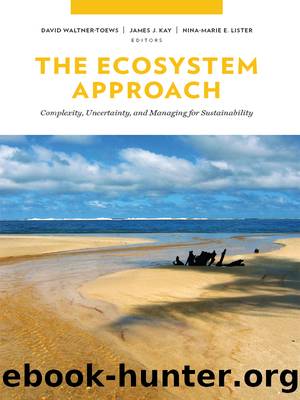The Ecosystem Approach by David Waltner-Toews

Author:David Waltner-Toews
Language: eng
Format: epub
Tags: SCI020000, Science/Life Sciences/Ecology, SCI012000, Science/Chaotic Behavior in Systems
Publisher: Columbia University Press
Published: 2008-07-20T16:00:00+00:00
Figure 11.2 Map of the Great Lakes Basinâpolitical boundaries and major cities. Map credit: National Oceanographic and Atmospheric Administration, Great Lakes Environmental Research Laboratory (www.glerl.noaa.gov/pubs/photogallery/albums/Misc/pages/1094.htm)
A Socioeconomic Perspective
The population of the GLB in 1991/1992 was over 39 million, an increase of 5.7 percent over the preceding decade. Urban land use accounted for 1 percent of the total basin area, mostly in the south, where 80 percent of the Basinâs population lived in only seventeen cities (Jarvis et al. 1996). The rest of the population lived in smaller cities and in rural areas.
Agriculture is an economically important industry in all GLB jurisdictions, with its eight American states (including portions outside the GLB) in 1991â1992 producing 30 percent of all U.S. sales in agriculture, for a return of $45 billion USD. Major products included corn, soybeans, and milk. There were 5 million hectares in agricultural production in Ontario (all of these in the GLB except the eastern tip of the province), and these produced 22 percent of all Canadian agricultural revenue. There were nearly 204,000 farms in the GLB in 1991â1992, of which 29 percent (59,000) were Canadian. Proximity to urban centers is typical of GLB farms, with 64 percent of farmland within 50 km of a major urban center (Jarvis et al. 1996).
Download
This site does not store any files on its server. We only index and link to content provided by other sites. Please contact the content providers to delete copyright contents if any and email us, we'll remove relevant links or contents immediately.
Time Management Made Easy: How to Cultivate New Habits, Improve Productivity and Get Things Done by Joshua Strachan(2384)
The 7 Habits of Highly Effective People by Stephen R. Covey & Sean Covey(2189)
The Concise Laws of Human Nature by Robert Greene(1782)
Doesn't Hurt to Ask by Trey Gowdy(1589)
Primal Leadership by Daniel Goleman(1199)
Hook Point: How to Stand Out in a 3-Second World by Brendan Kane(1145)
HBR's 10 Must Reads 2021 by unknow(1065)
Don't Sweat the Small Stuff...and It's All Small Stuff by Richard Carlson(1058)
Amazon Unbound by Brad Stone(1000)
100 Things Successful People Do by Nigel Cumberland(984)
HBR's 10 Must Reads 2021 by Harvard Business Review(974)
Master of One by Jordan Raynor(960)
The Job Closer by Steve Dalton(960)
Lives of the Stoics by Ryan Holiday & Stephen Hanselman(923)
Declutter Your Mind: A step by step guide to learn to control your thoughts, stop worrying, relieve anxiety and eliminate panic attacks and negative thinking by Mia Chandler(911)
The Power of 100! by Shaun King(894)
Conflicted by Ian Leslie(827)
Coders at Work: Reflections on the craft of programming by Peter Seibel(810)
The Book of Hope by Jane Goodall(788)
